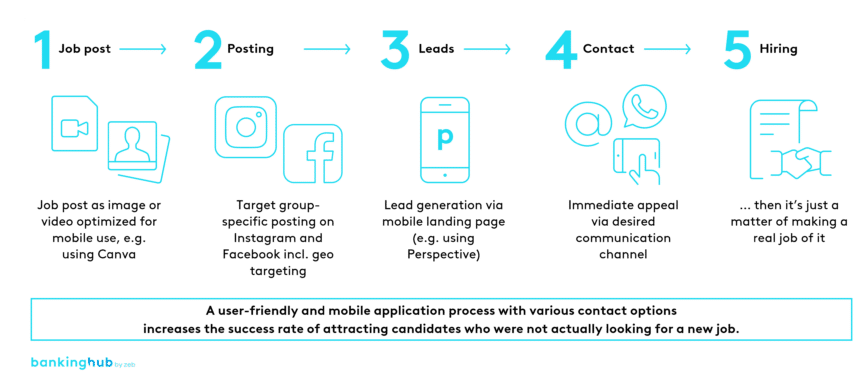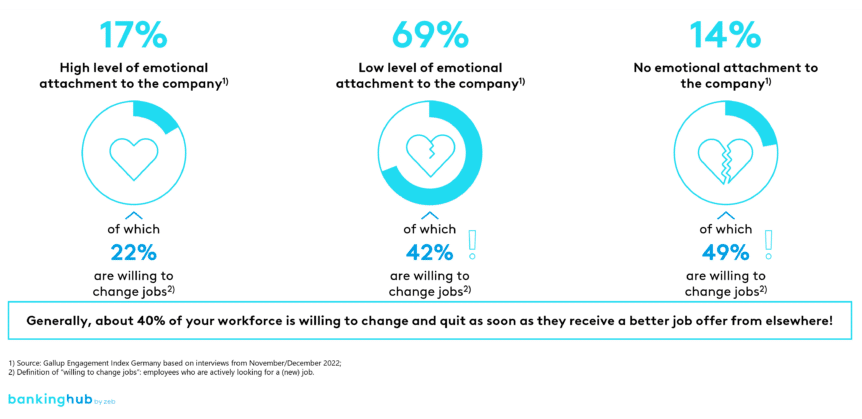The labor market is candidate-centred
Due to demographic change, increasing academization, greater urbanization and advancing digitalization, there is an ever-increasing shortage of skilled workers and specialists, which makes the labor market a candidate-centric market with near full employment. Today, companies have to apply to candidates, not the other way around.
Only a few are actively looking for a job
Conventional job advertisements only reach active job seekers. In Germany, they only make up 14% of the nationwide workforce.[1] The much greater potential: around 40% of employees are willing to change jobs,[2] but are not actively looking for one. Job advertisements on job platforms, business networks or company career pages are currently not reaching this target group.
The best candidates are usually not sitting at a desk
The target groups prefer mobile Internet access. More than 80% of users use apps such as Instagram mostly or exclusively on mobile devices.[3] Those who do not consistently optimize their offer for mobile use are basically “swiped away”.
Job advertisements miss the target groups
The wording of job advertisements is often to the relevant department’s liking. This means that up to 75% of the content is irrelevant and uninteresting for applicants.[4] If inauthentic stock photos are added to this, the content seems pretty random and tends to scare potential candidates away.
The right applicants are just one click away
Literally just one click! Those companies who still require applicants to create an application account, have them fill out pages of application forms or force them to copy out their CV should not be surprised that they hardly find any suitable candidates.
Recruiters are on LinkedIn – potential applicants are on Instagram
Candidates who are not actively looking for a new job do not read job postings on LinkedIn, Stepstone and the like. It is therefore only logical to approach them where they are: on social media.
“But we are already posting our job ads on social media!”
In our day-to-day work, we are often confronted with this note of desperation. However, it also shows the cause of this misunderstanding. It is not about posting the rather clumsy digital job ads on your own Instagram account or on Facebook.
Social media recruiting is not another channel, but a completely unique method of attracting candidates to fill a vacancy. And this method is not aimed at active job seekers who are already being addressed by Stepstone, LinkedIn and the like. The aim is to reach passive job seekers, that is all those who are willing to change jobs but do not actively look for one, via social media, Instagram and Facebook in particular. These candidates can be won over with easy-access offers that arouse curiosity and increase the motivation to move on.
BankingHub-Newsletter
Analyses, articles and interviews about trends & innovation in banking delivered right to your inbox every 2-3 weeks
"(Required)" indicates required fields
How does social media recruiting succeed?
But what is important to ensure successful social media recruiting aimed at passive job seekers? Making contact with passive job seekers requires a radical rethink. All recruitment processes must be consistently geared towards these potential candidates. This leads to far-reaching and comprehensive consequences for recruiting. While the processes have so far been designed to minimize the HR department’s workload, this approach will not get these companies very far in the future.
They need to understand that they are in a reverse application situation. They are now the ones who have to be attractive, flexible and approachable. And it is also the companies that have to invest attention, effort and passion in their recruitment activities.
It is all about attention and making contact quickly
There is a high number of people willing to change jobs who can be addressed with the right offer at the right time via the right channel. The challenge lies in standing out from the crowd, arousing interest and authentically conveying why a candidate should even consider joining the company. Getting in touch quickly and easily is the critical success factor here.
Based on our social media recruiting experience, we have developed specific recommendations:
1) Successful social media recruiting is aimed at employees who are willing to change jobs
Concentrate your search on employees who are willing to change jobs. Here you can draw on what is clearly the largest pool of potential candidates. Only 14% of employees are currently actively looking for a job[5]. By contrast, the proportion of passive job seekers is much higher: around 80% of employees in Germany feel little or no loyalty to their company, and 40% of employees are actually willing to change jobs.[6] Those who systematically deal with and open up this group have a clear competitive advantage.
And there is another reason for addressing passive job seekers: if you present your offer to this group, you also reach active seekers. But this does not work the other way around.
2) Effective job postings match the target group and motivate
Tailor your job postings to your target group. And remember: your target group is not actively looking for a job at the moment, but can be motivated with the right cue. In social media recruiting, the job posting should therefore emphasize the benefits and highlights of the vacant position. You need to address the motivation to change jobs in order to start a conversation with people who are willing to embrace such a change. The job posting must therefore appeal to your target group. This may not necessarily always be identical to what the company, the specialist department or HR are used to.
3) Little information, big impact – get to the point
Provide as much information about the job as necessary and as little as possible. In fact, passive job seekers only need a few pieces of information to pique their interest. These include: clear job title, qualifications required, salary range, location and responsibilities.
Especially information on remuneration can make a difference here. In a Stepstone study, 80% of respondents confirmed that they would like to see information about the company’s financial benefits (e.g. salary, company pension scheme, etc.) in a job advertisement.[7] But only very few companies dare to disclose that much. That’s a real shame, because a lot of potential is being wasted here that could be used for differentiation.
4) Mobile only
Everything that is circulated as a job posting should be consistently optimized for mobile use. Make sure that the time to load your job postings in mobile networks is reduced to a minimum. This can be achieved by using images sparingly, for example. Check their display in common mobile browsers such as Safari, Chrome, etc. Your job posting’s content should also be clearly structured. To increase readability on mobile devices, use groups of words instead of lengthy texts.
When posting jobs on social media, do not – by no means – redirect your leads to your career pages on the web. Redirect them to mobile landing pages such as Perspective, which are already fully optimized for mobile use.
5) Get in touch with interested candidates – no matter how, just do it quickly
Social media recruiting focuses on two goals: (1) arouse the curiosity and attention of passive job seekers and (2) make contact quickly. This way, they do not need a CV, an account or a cover letter, just the contact details.
To this end, simply offer several ways to get in contact and also go for alternatives such as WhatsApp in addition to e-mail and phone. Make it as easy as possible for interested persons to get in touch with you. And be quick to react when they do. Your quick response can make the biggest impression on prospective candidates.
Conclusion: social media recruiting in response to the shortage of skilled workers
The recruiting world continues to be in a state of flux, which is largely being shaped by the digital transformation. The expansion of recruiting activities to include passive job seekers via social media recruiting requires companies to rethink and redirect their strategy. Similar to e-commerce, it is about generating leads and then converting these leads without interruption.
A mobile and user-friendly application process that offers various contact options such as one-click processes and WhatsApp increases the success rate of attracting candidates who were not actually looking for a new job.








